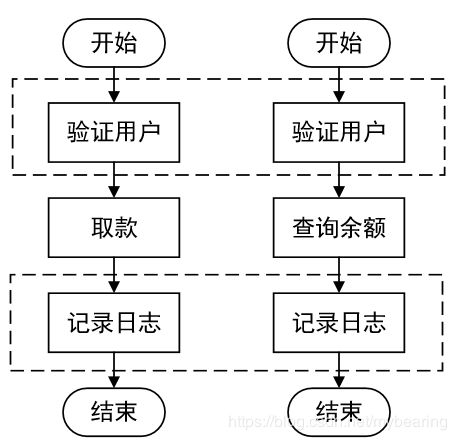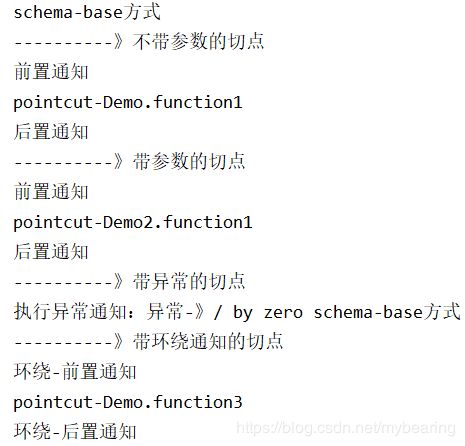Spring学习笔记-5(AOP)
文章目录
- 1.概述
- 2.基本概念
- 3.Spring中实现AOP
- 3.1.Schema-base方式
- 3.1.1.编写切点类
- 3.1.2.创建通知
- 3.1.3.配置applicationContext.xml文件
- 3.1.4.测试
- 3.2.AspectJ方式
- 3.2.1.编写切点类
- 3.2.2.创建通知
- 3.2.3.配置applicationContext.xml文件
- 3.2.4.测试
1.概述
- AOP(aspect oriented programming,面向切面编程)通过预编译方式和运行期间通过动态代理(利用java的反射机制或字节码技术)在不修改源代码的情况下给程序动态添加功能的一种技术。
- 如下图所示,取款和显示余额流程都需要进行用户验证和记录日志。利用AOP,可以把把这些重复性比较高的代码提取出来,在需要的流程中进行动态添加,提高了程序的可扩展性。

- 其本质就是一系列纵向的流程中,把相同的子流程提取出来成一个横向的面,然后切入到需要添加这个子流程的纵向流程中。
2.基本概念
- 切点:原有程序的功能,如上述的取款、查询、转账等。在Spring框架中,切点需要是一个特定的方法。
- 前置通知:添加到切点之前执行的功能,如上述的验证用户。
- 后置通知:添加到切点之后执行的功能,如上述的记录日志。
- 异常通知:切点所在执行过程中国出现异常执行的功能。
- 环绕通知:将前置通知和后置通知整合到同一个通知中。
- 织入:将通知添加到切点中的过程。
3.Spring中实现AOP
spring中提供了两种方法实现AOP,Schema-base和AspectJ。
3.1.Schema-base方式
该方法要求每个通知继承相应的类或实现相应的接口。然后配置applicationContext.xml中的aop:config标签。
3.1.1.编写切点类
这里在同一个包下定义两个类,包含了多种方法,用于配置不同的切点。
public class Demo {
public void function1() {
System.out.println("pointcut-Demo.function1");
}
public void function2() throws Exception{
int x = 5 / 0; //用于抛出异常
System.out.println("pointcut-Demo.function2");
}
public void function3() {
System.out.println("pointcut-Demo.function3");
}
}
public class Demo2 {
public boolean function1(String message, int num) {
System.out.println("pointcut-Demo2.function1");
if (num > 10) {
return true;
}
return false;
}
}
3.1.2.创建通知
- 前置通知
public class MyBeforeAdvice implements MethodBeforeAdvice {
/**
* @param method 切点方法对象
* @param objects 切点方法参数列表
* @param o 切点所在类的对象
*/
@Override
public void before(Method method, Object[] objects, Object o) {
System.out.println("前置通知");
}
}
- 后置通知
public class MyAfterAdvice implements AfterReturningAdvice {
/**
* @param o 切点方法返回值
* @param method 切点方法对象
* @param objects 切点方法参数列表
* @param o1 切点所在类的对象
*/
@Override
public void afterReturning(Object o, Method method, Object[] objects, Object o1) {
System.out.println("后置通知");
}
}
- 异常通知
虽然需要实现ThrowsAdvice接口,但是afterThrowing并非为必须重写的方法。
public class MyThrowingAdvice implements ThrowsAdvice {
public void afterThrowing(Exception ex) throws Throwable {
System.out.println("执行异常通知:异常-》" + ex.getMessage() + " schema-base方式");
}
}
- 环绕通知
public class MyAroundAdvice implements MethodInterceptor {
@Override
public Object invoke(MethodInvocation methodInvocation) throws Throwable {
System.out.println("环绕-前置通知");
Object result = methodInvocation.proceed(); //执行切点中的内容
System.out.println("环绕-后置通知");
return result;
}
}
3.1.3.配置applicationContext.xml文件
- 一个beans标签中可以定义多个aop:config标签来配置多组切点与通知。
- schema-base方式直接在aop:config标签中配置切点与通知。
- aop:pointcut中的expression属性用于指定一个或多个方法作为切点。*为通配符,用途为:1.通配方法的返回值(最前面的星号)、2.通配多个包路径(可以同时指定多个方法作为切点)。…为通配符,用于通配切点方法的形式参数。
- aop:advice中的advice-ref属性用于引用相应的通知实例。
- aop:advice中的pointcut-ref属性用于引用相应的切点。
<beans xmlns="http://www.springframework.org/schema/beans"
xmlns:xsi="http://www.w3.org/2001/XMLSchema-instance"
xmlns:aop="http://www.springframework.org/schema/aop"
xsi:schemaLocation="http://www.springframework.org/schema/beans
http://www.springframework.org/schema/beans/spring-beans.xsd
http://www.springframework.org/schema/aop
http://www.springframework.org/schema/aop/spring-aop.xsd">
<bean id="demo" class="com.bear.sxt.pointcut.Demo"/>
<bean id="demo2" class="com.bear.sxt.pointcut.Demo2"/>
<bean id="myBeforeAdvice" class="com.bear.sxt.advice.MyBeforeAdvice"/>
<bean id="myAfterAdvice" class="com.bear.sxt.advice.MyAfterAdvice"/>
<bean id="myThrows" class="com.bear.sxt.advice.MyThrowingAdvice"/>
<bean id="myAroundAdvice" class="com.bear.sxt.advice.MyAroundAdvice"/>
<aop:config>
<aop:pointcut id="pointcut" expression="execution(* com.bear.sxt.pointcut.*.function1(..))"/>
<aop:advisor advice-ref="myBeforeAdvice" pointcut-ref="pointcut"/>
<aop:advisor advice-ref="myAfterAdvice" pointcut-ref="pointcut"/>
aop:config>
<aop:config>
<aop:pointcut id="pointcutThrows" expression="execution(* com.bear.sxt.pointcut.Demo.function2())"/>
<aop:advisor advice-ref="myThrows" pointcut-ref="pointcutThrows"/>
aop:config>
<aop:config>
<aop:pointcut id="pointcutAround" expression="execution(* com.bear.sxt.pointcut.Demo.function3())"/>
<aop:advisor advice-ref="myAroundAdvice" pointcut-ref="pointcutAround"/>
aop:config>
beans>
3.1.4.测试
- 测试代码
public class Test {
public static void main(String[] args) {
ApplicationContext ac = new ClassPathXmlApplicationContext("applicationContext.xml");
Demo demo = ac.getBean("demo", Demo.class);
Demo2 demo2 = ac.getBean("demo2", Demo2.class);
/*使用schema-base方式*/
System.out.println("schema-base方式");
System.out.println("----------》不带参数的切点");
demo.function1();
System.out.println("----------》带参数的切点");
demo2.function1("hello", 20);
System.out.println("----------》带异常的切点");
try {
demo.function2();
} catch (Exception e) {
//e.printStackTrace();
}
System.out.println("----------》带环绕通知的切点");
demo.function3();
}
}
3.2.AspectJ方式
该方法不要求每个通知继承相应的类或实现相应的接口,只需要配置applicationContext.xml中的aop:config标签中的aop:aspect子标签即可。最终实现的效果和schema-base方式是一样的。
3.2.1.编写切点类
这里用到的切点类有两个带参数和返回值的方法。
public class DemoAspectJ {
public Object function(String message,int num) {
if (0 != num) {
System.out.println("pointcut-DemoAspectJ.function message:" + message);
return true;
} else {
int x = 5 / 0;
}
return false;
}
public Object function2(String message,int num) {
System.out.println("pointcut-DemoAspectJ.function message:" + message);
return 0;
}
}
3.2.2.创建通知
由于采用aspectJ方式,通知无需继承相应的类和实现相应的接口,所以每一个通知操作可以写成一个方法,多种通知可以写在同一个类中。
public class MyAdvice {
public void myBefore() {
System.out.println("前置通知");
}
/*message,num为切点参数*/
public void myBefore2(String message, int num) {
System.out.println("前置通知 " + message + " " + num);
}
public void myAfter() {
System.out.println("后置通知-出现异常继续执行");
}
public void myAfterReturning() {
System.out.println("后置通知-出现异常不执行");
}
public void myThrows(Exception e) {
System.out.println("执行异常通知:" + e.getMessage() + " aspectJ方式");
}
public void myAround(ProceedingJoinPoint p) throws Throwable {
System.out.println("环绕-前置");
Object result = p.proceed();
System.out.println("环绕-后置");
}
}
3.2.3.配置applicationContext.xml文件
- 一个aop:config标签中可以配置多个aop:aspect标签,一个aop:aspect标签相当于一个切面,包含了切点和通知。
- 由于所有的通知写在了同一个类中,所以需要在aop:aspect标签中使用ref属性引用通知所在类的实例。
- aop:pointcut标签用于配置切点。
- aop:before标签用于配置前置通知。
- aop:after标签由于配置后置通知(切点出现异常依然可以运行通知中的内容)。
- after-returning标签用于配置后置通知(切点出现异常后不执行通知中的内容)。
- aop:around标签用于配置环绕通知(通知需要定义一个ProceedingJoinPoint对象作为输入参数,利用该对象可执行切点方法)。
- aop:after-throwing标签用于配置异常通知,如果通知方法中使用了异常对象作为输入参数,则需要配置throwing属性,属性值为异常参数的参数名。
- 如果希望将切点的传入参数传递给前置通知,需要在aop:pointcut的expression属性中配置参数类型和参数名,并在相应的通知标签中配置arg-names属性。
<beans xmlns="http://www.springframework.org/schema/beans"
xmlns:xsi="http://www.w3.org/2001/XMLSchema-instance"
xmlns:aop="http://www.springframework.org/schema/aop"
xsi:schemaLocation="http://www.springframework.org/schema/beans
http://www.springframework.org/schema/beans/spring-beans.xsd
http://www.springframework.org/schema/aop
http://www.springframework.org/schema/aop/spring-aop.xsd">
<bean id="demoAspectJ" class="com.bear.sxt.pointcut.DemoAspectJ"/>
<bean id="myAdvice" class="com.bear.sxt.advice.MyAdvice"/>
<aop:config>
<aop:aspect ref="myAdvice">
<aop:pointcut id="pointcut2" expression="execution(* com.bear.sxt.pointcut.DemoAspectJ.function(..))"/>
<aop:around method="myAround" pointcut-ref="pointcut2"/>
<aop:before method="myBefore" pointcut-ref="pointcut2"/>
<aop:after method="myAfter" pointcut-ref="pointcut2"/>
<aop:after-returning method="myAfterReturning" pointcut-ref="pointcut2"/>
<aop:after-throwing method="myThrows" pointcut-ref="pointcut2" throwing="e"/>
aop:aspect>
<aop:aspect ref="myAdvice">
<aop:pointcut id="pointcut3" expression="execution(* com.bear.sxt.pointcut.DemoAspectJ.function2(String,int)) and args(message,num)"/>
<aop:before method="myBefore2" pointcut-ref="pointcut3" arg-names="message,num"/>
aop:aspect>
aop:config>
beans>
3.2.4.测试
- 测试代码
public class Test {
public static void main(String[] args) {
ApplicationContext ac = new ClassPathXmlApplicationContext("applicationContext.xml");
DemoAspectJ demoAspectJ = ac.getBean("demoAspectJ", DemoAspectJ.class);
/*使用AspectJ方式*/
System.out.println("aspectJ方式");
System.out.println("----------》不传递参数的通知");
demoAspectJ.function("张三", 10);
System.out.println("----------》传递参数的通知");
demoAspectJ.function2("李四", 20);
}
}


